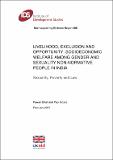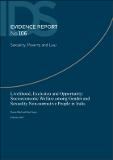| dc.contributor.author | Dhall, P | |
| dc.contributor.author | Boyce, P | |
| dc.coverage.spatial | India | en |
| dc.date.accessioned | 2015-02-03T09:41:16Z | |
| dc.date.available | 2015-02-03T09:41:16Z | |
| dc.date.issued | 2015-01 | |
| dc.identifier.citation | Dhall, P. and Boyce, P. (2015) Livelihood, Exclusion and Opportunity: Socioeconomic Welfare among Gender and Sexuality Non-normative People in India, IDS Evidence Report 106, Brighton: IDS | en |
| dc.identifier.uri | https://opendocs.ids.ac.uk/opendocs/handle/20.500.12413/5722 | |
| dc.description.abstract | In 2014, its 67th year as a sovereign country with a population of 1.21 billion (Government of India 2011a), India is the second most populous country in the world, the most populous democracy and has the longest written constitution among all sovereign countries. Its gross domestic product (GDP) is ranked tenth in the world (out of 184 countries) when measured through current prices (2014) and third on the basis of purchasing power parity (IMF 2014). In 1990, just before India embarked on an unprecedented economic liberalisation, the ranking by current prices was eleventh but by purchasing power parity it was ninth, indicating a significant jump forward in a 25-year period. Commensurate with the GDP growth (from around 5.5 per cent in the early 1990s to a peak of 10.3 per cent in 2010) (World Bank 2014), in spite of differences in poverty measurement between the Government of India, World Bank and the United Nations Development Programme, it is widely believed that there was significant reduction in poverty and that the government’s emphasis on economic growth was responsible for this (Aiyar 2011).
Against this background, this case study explores the socioeconomic experiences of gender and sexuality minority peoples in India, especially in respect of ways in which sexual and gender ‘difference’ may be correlated to economic hardship and restricted opportunities for livelihood in the context of Indian socioeconomic ‘modernity’. Growth of economic opportunity through neoliberal models of economic expansion is typically achieved via the extension of economic opportunity for some people amidst the endurance of ongoing socioeconomic precarity for most others. In this report we consider these issues in the context of livelihood, poverty, economic opportunity and restraint in the lives of gender and sexuality non-conforming people in India, with a specific focus on the eastern Indian states of Odisha and Manipur. These sites were chosen because in the last five years they have been among the states that have witnessed a number of community, government, non-governmental organisation and donor-backed initiatives undertaken on economic inclusion for people with non-normative genders and sexualities. | en |
| dc.description.sponsorship | UK Department for International Development | en |
| dc.language.iso | en | en |
| dc.publisher | IDS | en |
| dc.relation.ispartofseries | IDS Evidence Report;106 | |
| dc.relation.ispartofseries | IDS Evidence Report Brief;106 | |
| dc.rights.uri | http://creativecommons.org/licenses/by/3.0/ | en |
| dc.subject | Gender | en |
| dc.subject | Sexuality and Development | en |
| dc.title | Livelihood, Exclusion and Opportunity: Socioeconomic Welfare among Gender and Sexuality Non-normative People in India | en |
| dc.type | IDS Evidence Report | en |
| dc.rights.holder | IDS/University of Sussex | en |
| dc.identifier.ag | OT/11009/6/2/3/234 | |
| dc.identifier.ag | OT/11009/6/2/3/235 | |



